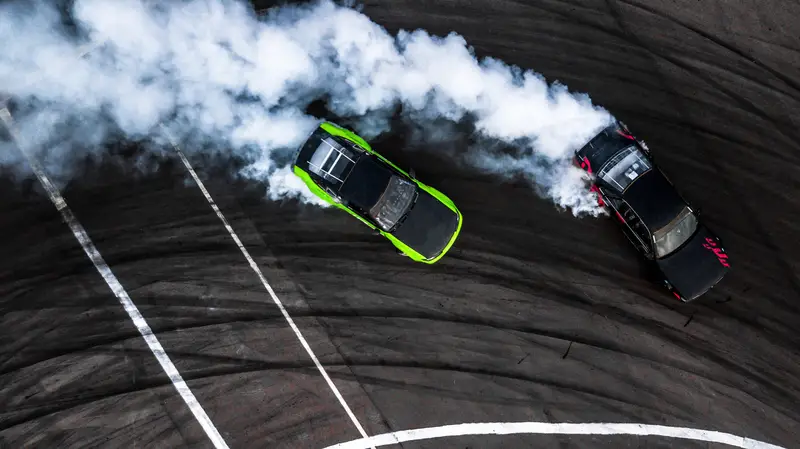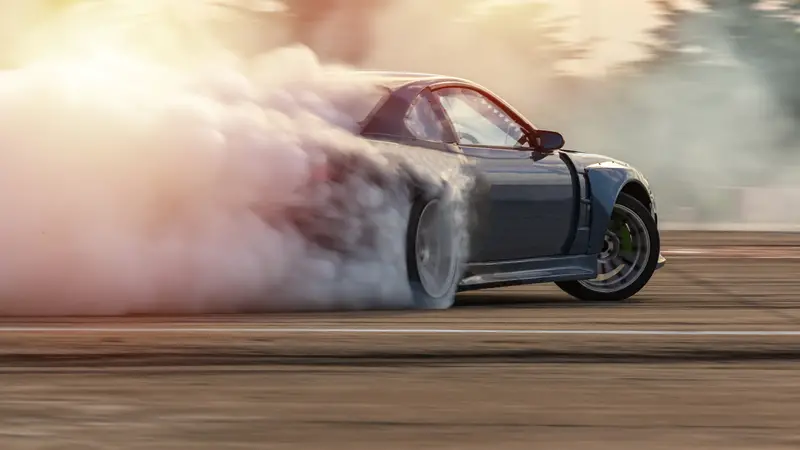
The screaming engines, squealing and tortured tires with the billowing clouds of smoke while the cars are driven on the edge of control is what drifting is all about.
The craze originally took hold in Japan and is now spreading around the world where professionals are racing around high-speed stadiums in the Western world, while some drivers in Africa conduct their own trials around the streets of squatter camps.
All types of cars can be drifted, irrespective of whether they are rear-wheel drive, front-wheel drive, or all-wheel drive. The easiest and most commonly used cars for drifting are powerful, lightweight, rear-wheel drive cars, such as the early generation BMW 3 series.
The skill required to drift a high-powered rear-wheel drive car around a track while in the company of other drifting cars is immense.
Not only do the drivers have to safely drift around corners, but they have to match the same angle as the cars driving next to them.
Can Any Car Be Drifted?
Unlike a skid which is generally a mistake that may lead to an accident, a drift is the deliberately initiated slide of a car that remains fully controlled by the driver using steering and throttle.
While some cars are easier to drift, based on the description above, a skilled driver can initiate a drift in any type of car, including:
- Rear-wheel drive cars
- Front-wheel drive cars
Rear Wheel Drive Cars
The most popular type of cars and the easiest to drift are two-wheel drive cars, with the drive wheels being at the rear.
The more powerful the engine (with high torque levels) and the lighter the car’s weight, the easier it is to initiate a drift.
Front-Wheel Drive Cars
Front-wheel drive cars are not as easy to drift as those with rear-wheel drive.
The torque generated by the rear wheel drive is unavailable; therefore, the handbrake (which works on the rear wheels) must be used to break the traction.
All-Wheel Drive Cars
One of the main purposes of an all-wheel drive car is to prevent the wheels from losing traction. If the four-wheel drive system can be deselected, it can be treated as a conventional rear-wheel drifting car.
If the system cannot be deactivated, the driver should use the same method as front-wheel drive cars.
How Are Drifts Initiated?

There are several ways a rift can be induced, either individually or in combination.
The variables which affect this include the following:
- The type of drive system in the car (2-wheel drive, front-wheel drive, all-wheel drive, etc.)
- The torque which the engine is capable of producing
- The condition of the tires
- The speed at which the car enters the corner
- The weight and balance of the car
Using the different capabilities provides several ways to initiate a drift.
Engine Power Oversteer (Rear Wheel Drive Cars Only)
A drift caused by excess engine power on the rear wheels. Assuming the car can brake, the rear wheels’ traction (while moving) enables this type of oversteer.
An engine power oversteer is initiated with the following steps:
- At the point where the drift is to start, the driver fully presses the accelerator (with force)
- The rear wheels lose grip when the torque produced by the engine exceeds the grip force available from the car’s rear wheel tires.
Clutch Slam Oversteer (Rear Wheel Drive, Manual Transmission Cars Only)
This is the most effective technique to start a drift where the engine is not powerful enough to initiate an engine power oversteer drift.
- As the driver approaches the corner, the weight is moved to the front axle, releasing the accelerator.
- If necessary, the brakes can also be lightly pressed to assist.
- The steering wheel is turned to follow the corner.
- Move to a lower gear and pop the clutch pedal back up while pushing down hard on the accelerator.
- The high engine revs and sudden application of torque (from the clutch release) will hopefully cause the drive wheels to break traction and the rear end to drift.
- As the car’s rear end steps out, the pressure in the accelerator is modulated, and the steering wheel is constantly adjusted to maintain the drift.
Weight Shifting Drift (Front And Rear Wheel Drive Cars)
Because no power (torque) is applied to the rear wheels, the brakes are used as a substitute for the engine.
Whenever a car is accelerated, the weight is shifted to the back of the car, and when it is braked, the rear end is lightened, and the front end becomes heavier.
Drifting a car requires the rear end to be lightened, and with front-wheel drive cars, the only way of achieving this is to use a combination of speed and judicious braking.
To start a drift, use the following sequence:
- Accelerate towards the corner and start steering into it at the beginning
- Simultaneously apply the brakes to lighten the rear end, which should start to “step out”
- To reduce the drift, accelerate, placing the weight back onto the rear end
- Because the power delivery is to the front wheels, the engine cannot be used to maintain the drift. This means drifting for a long distance; starting at as high a speed as possible is necessary
The Scandinavian Flick (Rear Wheel Drive Cars And Front Wheel Drive Cars)
The Scandinavian flic is the most elegant way to start a car drifting, and while it takes some practice to perfect it, it is the normal method used by most competitive drift drivers.
To start a drift with a Scandinavian Flick, follow the steps below:
- The principle of this method is to create a side-to-side rocking motion to unsettle the car’s balance before the turn has started
- Just before the rotate the steering wheel the opposite way of the corner
- Quickly correct it back while accelerating
- The car’s rear will step out, and the degree of drift can be adjusted with the steering wheel, brake, and accelerator
Hand Brake Drifting (Rear Wheel Drive Cars And Front Wheel Drive Cars)
While all methods of rifting are punishing in the tires, this method is particularly so and should preferably be practiced on wet or even icy surfaces.
When the car is in the corner, pull up the hand break and watch the rear end break traction and start to drift.
Conclusion
All cars can drift; however, some drive train layouts are much easier to initiate the drift with particularly rear-wheel drive cars, which have excess power available, and which are light.
